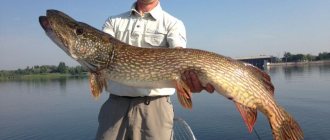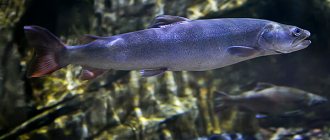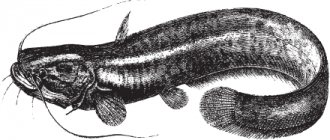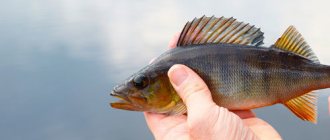For millions of years, our planet has been inhabited by a large variety of fish. Their habitat became numerous lakes, rivers, seas and oceans. Since ancient times, both river and sea inhabitants of the underwater kingdom have served as a source of food for people, rich in a huge amount of useful substances, such as various amino acids, protein and various vitamins. Fish farming products are widely used in the manufacture of medicines and nutritional fertilizers for agriculture, as well as raw materials in light industry.
Predatory fresh water fish
Soma
These predatory fish of reservoirs are represented by more than 10 species. Most of them are aquarium. They are small. But the common catfish is the largest predatory river fish . In the last century, 5-meter individuals weighing about 400 kilograms were caught. In the 21st century, the maximum weight of a caught catfish was 180 kilos.
The small predatory fish among catfish is the glass species. In the natural environment, its representatives are found in India. The glass catfish is transparent, only the head is not visible.
Pike-perch
There are 5 types. All have an elongated body with large scales. It covers all the fish. She has an elongated, pointed head. It is slightly flattened on top. All pike perch also have a sharp and high fin sticking out on their back. It, like the entire top of the fish, is gray-green. The animal's abdomen is gray and white.
Pike perch are large predators and can exceed a meter in length. The weight of the fish is approximately 20 kilograms.

Piranhas
There are 50 species of piranhas. All are carnivorous, living in fresh water bodies of the tropics of South America. Piranhas do not exceed 50 centimeters in length. Externally, the fish are distinguished by their laterally flattened body and silver, gray or black scales. Yellow, scarlet or orange markings may be present on a dark background.
All piranhas have a forward lower jaw. Triangular teeth are visible. They are sharp and closely meet the upper ones. This adds destructive power to the fish's bite. An adult piranha easily crushes a stick with a diameter of about 2 centimeters.
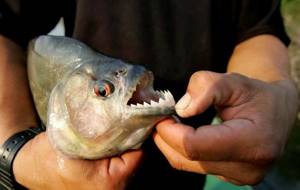
Pike
There are about 10 species of them in fresh water bodies. The Aquitaine pike, which lives in the waters of France, was discovered only in 2014. The Italian species is isolated from others in 2011. The Amur pike differs from the usual small silvery scales and is smaller itself.
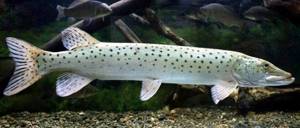
There are also fish with black stripes above their eyes. These live in America and do not gain weight more than 4 kilos.
The largest in the family is the masking. The sides of this pike are covered with vertical stripes. The Muskinong stretches up to 2 meters, weighing almost 40 kilos.
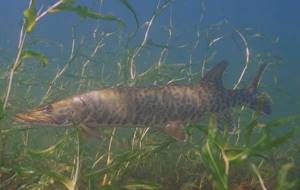
Pike is a predatory fish that plays the role of a water orderly. Weakened fish and amphibians are the first to fall into the predator's mouth. Cannibalism is developed in the family. Large pikes readily devour smaller ones.
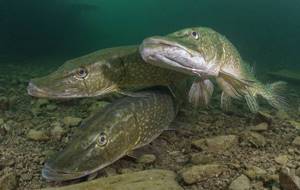
Perches
There are more than 100 species in the family. About 40% of them are marine or semi-anadromous. Among freshwater perches, the most common is river perch. It is united with others by greenish transverse lines on the sides.
The pattern is weakly expressed if the bottom of the reservoir is light. If the bottom is dark, for example, muddy, the stripes on the sides of the perches are rich in color.
Perch is a predatory freshwater fish that feeds on its own young. This is true in reservoirs where perch predominates among other species. In addition to juveniles, adult animals eat other fish.
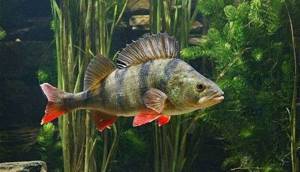
Arapaima
This is a tropical predator that lives in the tributaries of the Amazon. There is a bony plate on the elongated and flattened head of the fish. At the same level with it is the wide mouth of the arapaima. Its body is thick, but flattened laterally, tapering towards the tail.
The fins, like those of eels, are fused together. However, the body of the fish itself is not so long. Arapaima looks like a chopped off, shortened and fattened eel.
Arapaima has prominent and large scales. It is tightly planted and strikes with elasticity. Its modulus is 10 times greater than that of bone.
Arapaima feeds on bottom-dwelling fish, as it stays near the bottom. If a predator floats to the surface, it can even swallow a bird flying over the water.
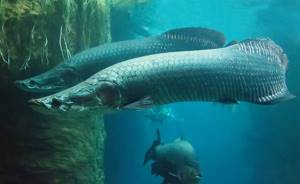
Burbot
It feeds on minnows, ruffs, and young fish of various types, including those of its own species. The moving whisker on the burbot's head lures prey. He himself hides in the silt or under a snag, in a depression in the bottom. U sticks out like a worm. The fish want to eat it, but in the end they themselves are eaten.
Burbot is included in the predatory fish of lakes and rivers. Reservoirs with cool, clean water are selected. There, burbots reach a length of 1.2 meters. The weight of the fish can reach 30 kilos.
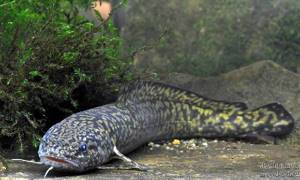
Ruffs
There are sea ones. In salty waters, fish of the family reach 30 centimeters in length. Four varieties of river ruffs extend to a maximum of 15 centimeters. This size is enough to feed on the larvae of aquatic insects and the eggs of other fish.
Ruffs find food in shaded, bottom areas of reservoirs. True, there are burbots waiting for hunters there, feeding on them. Which predatory fish will win the fight is a rhetorical question.
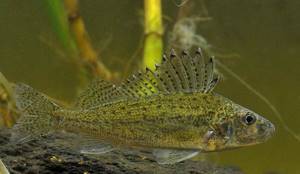
Gustera
It resembles a bream, but leads a gregarious lifestyle. In addition, the silver bream has silvery scales, but there are none on the keel behind the fins.
Young silver bream eat zooplankton. Growing up, fish switch to a diet of mollusks. They are supplemented by algae and underwater parts of terrestrial plants.
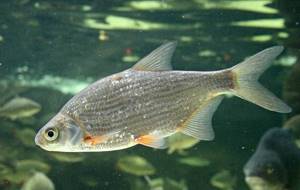
Predatory fish of salt waters
Moray eels
These predatory marine fish come in more than 200 species. The closest relatives are eels. However, they are also found in fresh water bodies. Externally, moray eels are snake-like. The fish of the family are elongated, slightly flattened on the sides.
The body tapers towards the tail, like a leech's. The fin on the back of the fish stretches from the head to the end of the body. There are no other fins. The minimum body length of a moray eel is 60 centimeters. Representatives of the giant species stretch almost 4 meters, while weighing about 40 kilograms.
The elongated head of the moray eel with an angry expression in the eyes and a slightly open mouth is equipped with rows of sharp teeth. The mouth is open for breathing. The moray eel's body is usually hidden in crevices between stones and corals. It is difficult to move the gills there, there is no flow of oxygen.
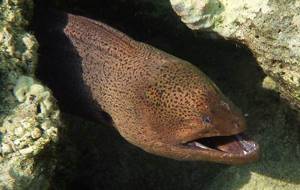
Acne
There are 180 species in the seas. Unlike moray eels, eels are monochromatic. The bodies of the relatives are dotted with patterns. Acne is also less aggressive. Moray eels sometimes even attack people. In ancient Rome, by the way, guilty slaves were sometimes thrown into pools with sea fish.
They were kept for cooking. The Romans considered moray eel meat a delicacy.
Like moray eels, eels have fused tail, back and anal fins. At the same time, there are separate chests. They, like the entire body of the eel, are covered with mucus. The fish has no scales. However, moray eels also do not have body plates.

Barracuda
Represented by 27 species. They are called tigers of the ocean. The nickname refers to the ferocity of the fish. She, like a moray eel, even attacks people. Approximately 100 cases are recorded per year. Half of the victims die from their wounds. So, barracuda can be safely considered one of the most predatory fish in the ocean.
Outwardly, the barracuda resembles a pike, but is not related to it. The oceanic predator belongs to the perciform ray-finned fish. The length of a barracuda rarely exceeds a meter. The standard weight of an animal is 10 kilograms.
It seems that a predator of this size can hardly harm a person. However, barracudas are schooling fish and also attack together.
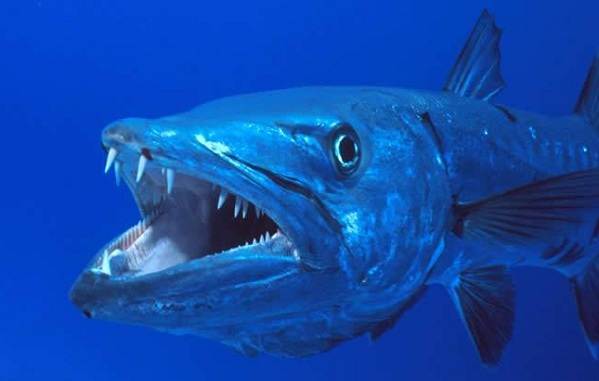
Toad fish
They belong to the batrach family. There are 5 species of toad fish that live in the oceans. The name was given to them for their large and wide head, as if flattened on top, a wide mouth, a protruding lower jaw, protruding round eyes, and wrinkled gray or brown-green skin.
The length of representatives of the genus does not exceed 35 centimeters. The skin of fish, like that of ordinary toads, is bare and devoid of scales.
The toad fish can change color, adapting to the colors of the environment and the bottom. This makes predatory fish species especially dangerous. You may not notice a toad in shallow water, step on it, or touch it. Meanwhile, there are poisonous outgrowths on the body of fish. For humans, the injection is fatal. However, irritation, pain and swelling at the site of the poison are pronounced.

Sharks
There are more than 400 species of them in the seas and oceans. Representatives of some do not exceed 20 centimeters in length, while others stretch up to 20 meters. Such, for example, is the whale shark.
In the generally accepted sense, it is not a predator, feeding on zooplankton. A typical predator is the white shark, reaching a length of 6 meters.
All sharks have common features. These are: a cartilaginous skeleton, the absence of a swim bladder, an excellent sense of smell, which allows you to smell blood from 5-6 kilometers away. All sharks also have gill slits and breathe oxygen, and have a streamlined body shape. The latter is covered with scales and has raised projections.
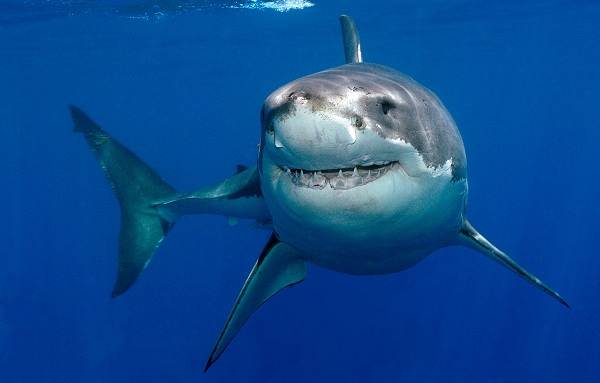
Needlefish
It also has a freshwater variety. It lives in the reservoirs of India and Burma. Like most marine species, the freshwater pipefish is small, reaching a maximum length of 38 centimeters.
With such a length, the real body weight is several hundred grams. However, the body of the needle is so thin that it weighs several times less. Therefore, fish is rarely used as food - there is little “fat”.
The closest relatives of needle fish are seahorses. However, their spine is a normal color. The bones of the needles are greenish. This is not associated with toxicity. The green color comes from the harmless pigment biliverdin.
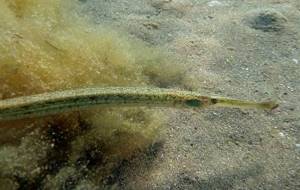
Arrowfish
From these distant relatives of needles you can get a substantial profit. Large representatives of the genus gain 6 kg mass. Arrows are systematically classified as garfish, that is, they are close in blood to flying fish.
If the needles can only encroach on crustaceans and newborn fry of other small fish, the arrows feed on sand lance, sprat, and juvenile mackerel. They eat garfish and gerbil. By the way, needles are also included in the diet of arrows.
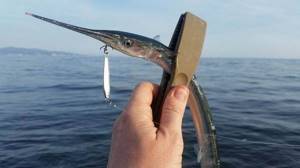
Sea devils
The photo of predatory fish represents almost 10 species of devils. All of them seem to be pressed down from above, that is, low and wide. The body narrows sharply towards the tail. The first two-thirds of the length of the line is occupied by the head. Therefore, in general, the body of the fish is like a triangle spread out along the bottom.
Fish mouth with a snack. The protruding lower jaw is equipped with sharp teeth. They are bent inside the mouth. There are similar ones on the upper jaw. The mouth opens like a snake's. This allows the devils to swallow prey that is larger than them.
Representatives of large species of monkfish reach 2 meters in length. In this case, about half a meter is accounted for by the growth with a luminous capsule at the end. The flashlight is located on the devil's face and attracts prey. The devil himself camouflages himself at the bottom, burrowing into silt and sand.
All that remains is the lamp. As soon as the prey touches it, the devil swallows it. By the way, fluorescent bacteria glow.

Catfish
These are eel-like fish that live only in the seas. Systematically, catfish are classified as perciformes. The bite of predatory fish is rare, since the animal is deep, descending to 400-1200 meters. This is partly due to the catfish's love of cold water. Its temperature should be below 5 degrees.
A catfish can only swim to the surface in pursuit of prey. However, its predator usually finds it at depth, feeding on jellyfish, crabs, starfish, and other fish.
The animal digs into them with sharp, knife-like teeth. Among them there are pronounced fangs. Therefore, catfish is also called sea wolf.
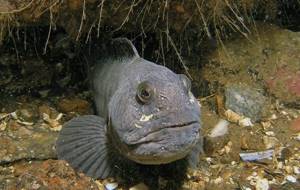
bluefish
Not divided into varieties. In the bluefish family there is one genus with a single species of perciform fish. They can exceed a meter in length. The maximum weight of a bluefish is 15 kilos.
On the back of the bluefish’s laterally flattened body there are fins with cartilaginous rays. The tail fin of the fish is shaped like a fork. The thoracic and abdominal outgrowths are also in place. They, like the entire body of the bluefish, are colored blue. It has a hint of green in it. The back is several times darker than the belly.
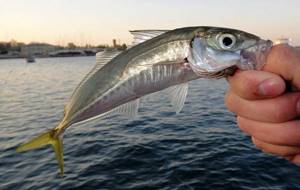
Eel-pout
Has several subspecies. The most common of them is regular or European. There are also American and eastern eelpouts. Catching predatory fish is unpopular due to the repulsive appearance of the animal.
The eel-like body is gray-green and covered with small scales. The eelpout's skin is thick and rough. The freshwater burbot has a similar appearance.
Like burbot, eelpout loves cool waters. At the same time, the fish stays in shallow water, off the coast of the seas. The water there warms up more than at depths. Therefore, the eelpout chooses cold seas, feeding on mollusks, crustaceans, caviar, and fry.
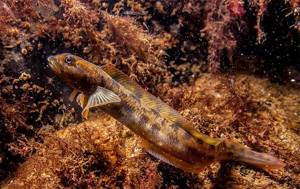
2) Electric eel
Electric eel (lat. Electrophorus electricus
) is a fish that belongs to the family Gymnotaceae and is a closer relative of the catfish than the common eel. This unusual fish lives in the waters of the Amazon and Orinoco rivers, which flow in South America. In freshwater rivers and their basins, electric eels hunt prey and protect themselves from enemies with the help of special organs that are capable of delivering strong electric shocks.
The electric eel swallows air from the surface of the water to breathe. Thanks to special internal organs, they can produce an electrical charge with a voltage of up to 1300 Volts and a current of up to 1 Ampere. This may be enough to kill an adult.
Electric eels primarily hunt invertebrates, but adults can feed on fish and even small mammals. People are attacked extremely rarely, and only if they are too angry. They prefer to live in muddy, stagnant water. Scientists have long been interested in this eel and are studying in detail its ability to generate electricity.
Migratory predatory fish
Sturgeons
Like all migratory fish, part of their lives swim in the sea, and part of their lives in rivers. The group includes about 20 species. Among them: Kaluga, Siberian and Russian sturgeon, shovelnose, beluga, stellate sturgeon, sterlet, thorn. All of them are cartilaginous and have no bones, which indicates an ancient origin.
Sturgeon skeletons are found in sediments of the Cretaceous period. Accordingly, fish lived 70 million years ago.
The largest sturgeon caught weighed about 800 kilograms. This is with a body length of 8 meters. The standard one is about 2 meters.

Salmon
The family is represented by salmon, pink salmon, whitefish, coho salmon, whitefish or, as it is also called, nelma. They resemble grayling fish, but have a shortened fin on the back. It has 10-16 rays. From whitefish, which salmon also resemble, the latter are distinguished by their brighter color.
Salmonids are widespread and variable. The latter term means different nuances in the appearance of the same species, but in different territories. Hence the confusion of classifications.
One name can be given to 2-3 salmon in different countries. It also happens the other way around, when there are about 10 names for one species.
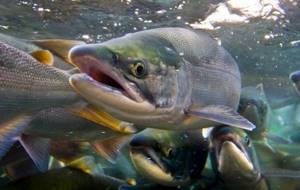
Gobies
They belong to the order Perciformes. It includes 1359 species of fish. About 30 of them live in Russian water bodies. All of them are bottom-dwelling and stay near the coast. There are freshwater, marine and anadromous gobies.
However, all representatives of the genus are tolerant of waters of different salinities. Gobies move from the shores of the seas to the rivers that flow into them and do not always return. Freshwater species can also move to the sea for permanent residence. That’s why bulls are called semi-nadromous.
The diet of gobies includes bottom worms, mollusks, crustaceans, and small fish. The smallest predators do not exceed 2.5 centimeters in length. The largest bulls grow up to 40 centimeters.

Bream
His name is included in the names of predatory fish , since the representative of cyprinids feeds on bloodworms, plankton and other crustaceans and invertebrates.
Interestingly, semi-anadromous breams live about 8 years less than freshwater ones. The last century is about 20 years. The same can be said about other semi-anadromous cyprinids, for example, carp or roach.
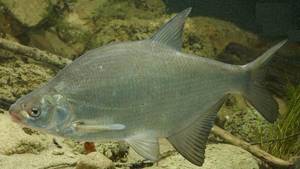
Most predatory fish are concentrated in the warm, marine waters of the tropics. Herbivorous species are more common in cool and fresh water bodies.
Features of river fish
The behavior of freshwater individuals differs little from sea inhabitants. The basic principle of their presence in water is simple: the larger the fish, the deeper the horizon of the reservoir where it spends the main time of its existence.
River fish often migrate in search of food due to changes in temperature and atmospheric pressure. The habitats of river fish largely depend on the time of year. In the spring, they usually go to river mouths or to areas overgrown with grass to spawn.
In summer, when the water warms up, many individuals go out to open areas of reservoirs with clear water. And with the onset of cold weather, especially in the dead of winter, many freshwater animals go to depths, into pits, where they almost fall into suspended animation and become inactive.
The main feature of river fish: they can be predatory or peaceful. Carnivores feed on their own kind, only smaller in size. Peaceful people prefer plant foods. But this division is conditional.
For example, the ruffe does not eat plant food, but it cannot hunt anyone due to its small size, so its main diet is insects and small larvae.


